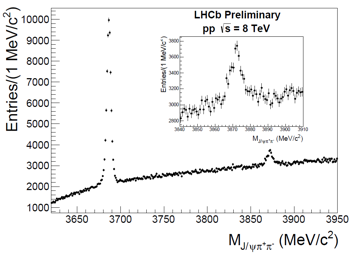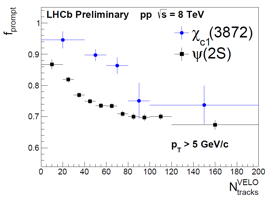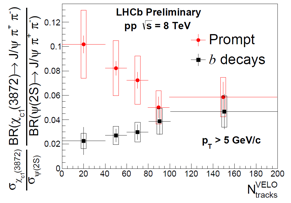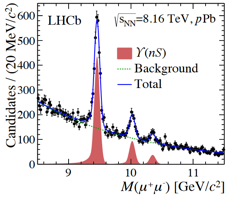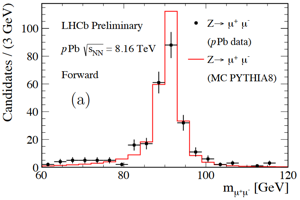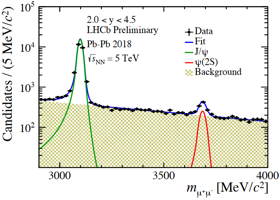The LHCb Collaboration presented several new interesting results at the Quark Matter 2019 conference in Wuhan, China. Among them was a study of how the production rate of the exotic meson candidate χc1(3872) (historically known as the X(3872)) in pp collisions depends on the multiplicity – the number of particles in the event.
In the conventional quark model, strongly interacting particles known as the hadrons are formed either from quark-antiquark pairs (mesons) or three quarks (baryons, or antibaryons for three antiquarks). Particles that interact strongly but cannot be classified within this scheme are referred to as exotic hadrons. LHCb discovered particles composed of four quarks and an antiquark (pentaquarks) and made essential contribution to study of particles composed of two quarks and two antiquarks (tetraquarks). The χc1(3872) was first discovered in the mass spectrum of J/ψπ+π– in B-hadron decays at Belle, and has since been confirmed in multiple decay modes at other experiments including LHCb. Multiple explanations of the χc1(3872) structure have been proposed. Shortly after its discovery, it was considered as one of several possible charmonium (cc) states. However, LHCb measurements have since confirmed the quantum numbers to be JPC = 1++, which disfavours an assignment as a conventional charmonium particle because no compatible charmonium states are expected to exist near the measured mass. The remarkable proximity of the χc1(3872) mass to the sum of the masses of the D0 and D*0 mesons led to the consideration that its structure might be a hadronic molecule, i.e. a state consisting of these two mesons loosely bound together. In this case, the binding energy of the χc1(3872) hadron would be small and its radius large.
Weakly bound quarkonia (cc, bb) states have been studied extensively in proton-nucleus (pA) and nucleus-nucleus (AA) collisions. Measurements of charmonia production in pA collisions showed that the ψ(2S) is suppressed more than the J/ψ in rapidity regions where a relatively large number of charged particles are produced; this is expected since the ψ(2S) is more loosely bound than the J/ψ. If the χc1(3872) is a hadronic molecule, similar effects could also disrupt its formation in dense environments. The LHC has produced large samples of pp collisions, including high-multiplicity pp collisions that provide a hadronic environment that approaches heavy-ion collisions in many respects. Recently, phenomena typically thought only to occur in collisions of large nuclei have been observed in high-multiplicity pp collisions. Thus, if the χc1(3872) is a hadronic molecule, suppression effects might also be seen in high-multiplicity pp collisions.
The LHCb collaboration presented measurements of the fractions of χc1(3872) and ψ(2S) states that are produced promptly (directly at the pp collision point), fprompt, in pp collisions at 8 TeV as a function of the event activity. The χc1(3872) and ψ(2S) candidates are reconstructed through their decays to J/ψπ+π– as seen in the image above. The insert plot shows a zoom around χc1(3872) mass.
Promptly produced particles may interact with hadrons produced at the same time in the pp collision. A very important feature of the LHCb analysis is the ability to compare the promptly produced χc1(3872) and ψ(2S) particles with those from decays of B hadrons. This comparison is very interesting because B hadrons live long enough to fly a few mm and decay in the vacuum outside the pp collision region – and therefore the χc1(3872) and ψ(2S) produced in B hadron decays never interact with the dense environment at the pp collision point, and so could not experience the suppression effects mentioned above.
The left image shows the fraction fprompt of promptly produced χc1(3872) and ψ(2S), as a function of the number of tracks reconstructed in the VErtex LOcator (VELO), which is a measure of the event activity. For both mesons, the value of fprompt decreases as the event activity increases. The right image shows the ratio of the χc1(3872) and ψ(2S) production cross sections for prompt and B hadron decay production (denoted “b decays”), again as a function of the number of tracks reconstructed in the VELO. Moving from low to high multiplicity, the data suggest that prompt χc1(3872) production is suppressed relative to prompt ψ(2S) production. This would be expected in a scenario where interactions with co-moving hadrons produced in the collision dissociate a large, weakly bound χc1(3872) particle more than the relatively compact conventional charmonium ψ(2S) particle. In contrast, the ratio of cross sections for production in B hadron decays does not display any significant dependence on event activity. (The central values of the black points increase gradually, but within uncertainties are consistent with being flat.) These results will be of interest both to theorists studying the possible exotic nature of χc1(3872) particle and those investigating dense hadronic matter. Read more in the conference presentation and in the conference note.
Results from LHCb on Open and hidden beauty production as well as Z boson production in pPb and Pbp collisions were also presented at the conference. These allow the study of cold nuclear matter effects, and to how they can be disentangled these from quark-gluon plasma effects (see an introduction to the topic). The images above show the production of different bb quark bound states (ϒ mesons) and Z boson production in pPb collisions as well as production of two charmonium states (J/ψ and ψ(2S)) in ultra-peripheral Pb-Pb collisions. The LHCb Upgrade will provide an excellent opportunity for unique and groundbreaking insights on the intrinsic properties of the heavy ion physics to be made in the LHC Run 3 and 4.

